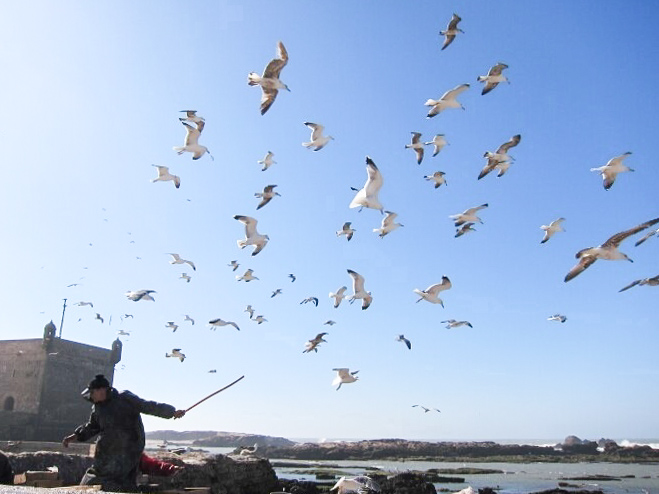Essaouira may be influenced by the Brittany region of France, but the laidback fishing village is unmistakably Moroccan.
In a country known for land-locked cities and dramatic deserts, Essaouira reminded us that Morocco actually has an expansive coastline. The fortified coastal town, known as “The Windy City,” is less than four hours by bus from Marrakech. Situated along the North Atlantic Ocean, the UNESCO World Heritage site is a magical place to spend a few days.
At one point, Essaouira was the main port in the entire country. The city was designed by Marquis de Vauban, the French military architect who designed the well-known port town of Saint-Malo in Brittany, France. Throughout our time in Morocco, it was fascinating to notice the French influences that had seeped into everyday life. While the country’s official languages are Arabic and Amazign (the indigenous language), over 30% of Moroccans speak French. The thriving cafe culture is a testament to France as well.
Upon arrival, we checked into Riad Lunetoile, a cozy guesthouse with a beautiful terrace offering panoramic views of the city. We immediately set out to explore – per the usual, we found ourselves referencing other cities we’ve visited. The white washed buildings of Evora, Portugal. The narrow streets lined with trinket shops took us back to Aguas Calientes, near Machu Picchu. And the seaside working town vibes were similar to those in Korcula, Croatia.
As we made our way down Avenue de l’Istiqlal, the old town’s main thoroughfare, we encountered a host of interesting locals.
There was a man selling desserts that his wife made, a vendor who solely cooked snails all day, and a trio of roving musicians playing traditional instruments. A woman, obscured in a full black burqa, guided her young son down the street. He peered over his shoulder, look at us curiously. A barber gave Brian a steely glance and noticing his vagabond beard, simply stated, “It’s time.” We found this remark hilarious and ended up referring to it later on in our travels. Particularly handy when one or both of us needed to give our wandering nomadic appearance some attention.
Occasionally, a young man would approach us to gauge our interest in hash. Clearly, an offer in which other backpacking tourists partake. Instead, we headed to Chez Miloud – more than once – for delicious crepes (“Msemen” in Arabic) and mint tea. The perfect fusion of France and Morocco.
An individual we were most struck by was a young wheelchair-bound man. Paralyzed from the neck down, a canvas and eisel was set up before him. While delicately holding a paintbrush in his mouth, he used small brush strokes to create beautiful scenes of the coast. Remarkable.
Like many cities in Morocco, Essaouira became a haven for celebrity hippies during the 1960s and 1970s. Famous artists like Cat Stevens and Jimi Hendrix flocked to the area and eventually, helped boost the tourism there.
Beyond the main square, Place Moulay Hassan, we headed to Essaouira’s lively port area.
Flocks of seagulls in the air, we passed through the majestic Marine Gate and entered the fascinating old harbor. We first observed the hundreds of fishing boats floating in the water – painted an iconic blue to apparently not scare away any fish. We felt dwarfed by the enormous, old fishing trawlers docked for repairs and touch-ups, still in use to this day. Some fishermen tended to their nets, while others came in with the latest catch from hours out at sea.
Eventually, we made our way to the expansive beach. A group of young men set up temporary goal posts to play soccer. As it was off-season (February), most of the resorts’ beach chairs and umbrellas weren’t being used. Despite the fairly chilly weather, we did see a few brave tourists sunbathing – given their swimwear style, likely from Europe.
Finally, we reached La Scala and the Essaouira Ramparts. We wandered the ground level that once served as a military storage area, and browsed the local shops. Ascending to the top level, panoramic views of the water instantly greeted us. We strolled along the fortification passing by stray cats and dogs peacefully lying in the sun. We came across a row of old Spanish cannons and were reminded of the town’s past naval battles.
Amazing to reflect on how time has transformed these city walls from a place of war to one of serenity.

